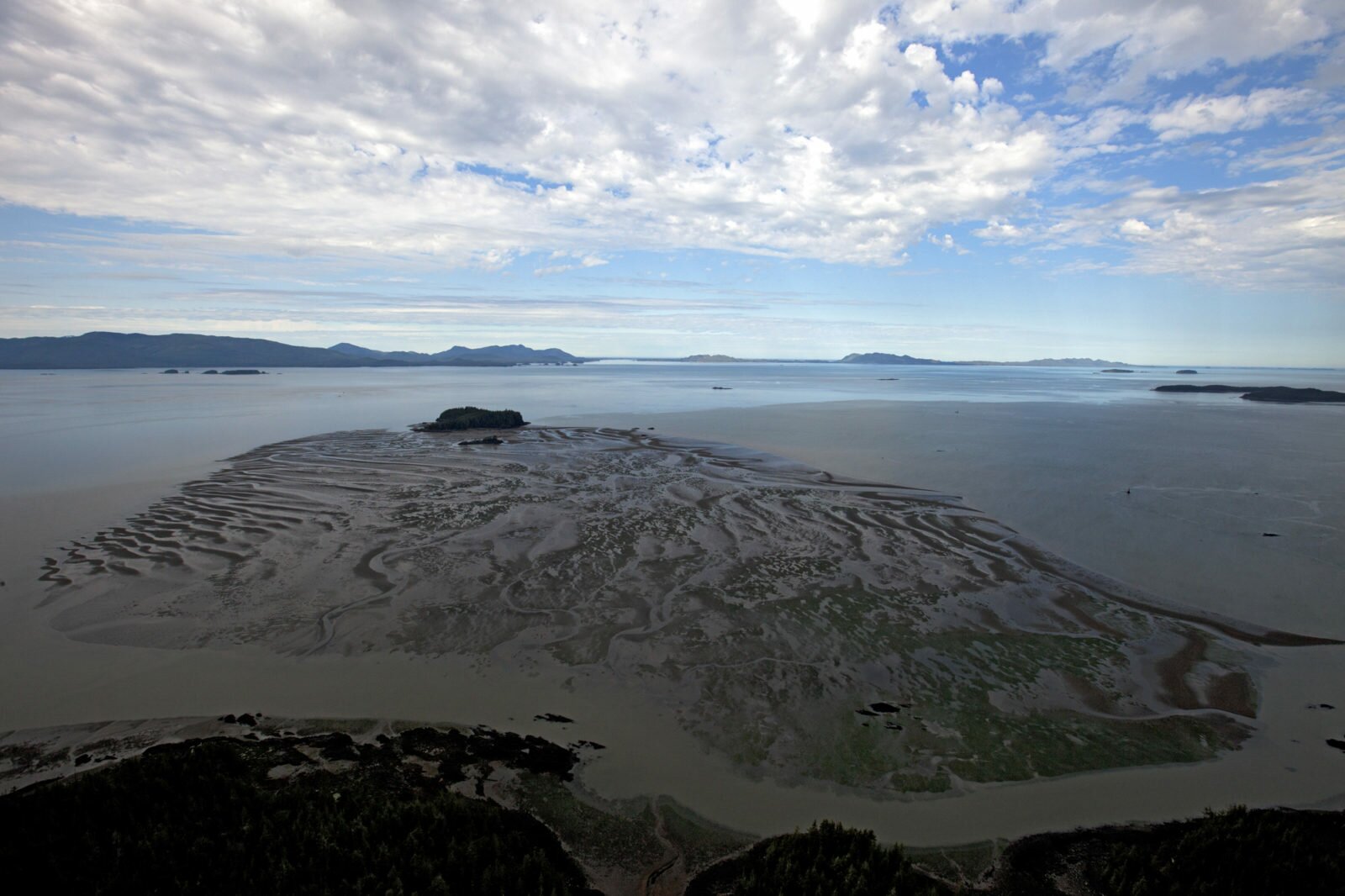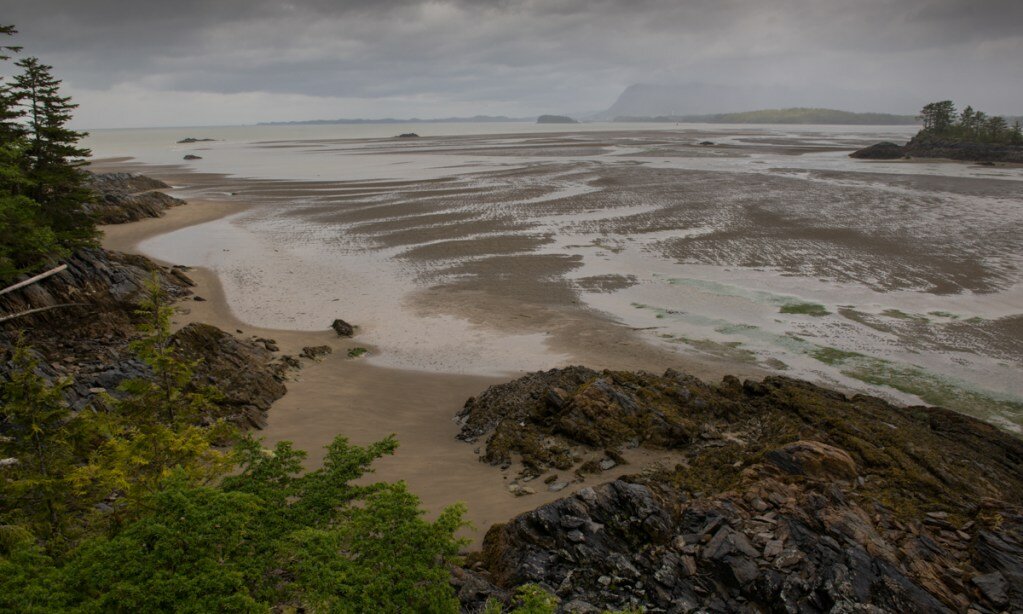Accusations of misinformation at First Nations’ community meetings about Pacific Northwest LNG
With the $36-billion energy project slated for their front yard, members of Lax Kw’alaams First Nation get an update from their elected council

Over the past two weeks, Lax Kw’alaams First Nation held community meetings to weigh the benefits and risks of Pacific NorthWest LNG. The $36-billion gas project proposed for the mouth of the Skeena River, in northwestern B.C., is causing tension in the community, and the recent meetings bring new allegations of misinformation and manipulation.
The meetings, officially called “community information sharing sessions,” were held in Lax Kw’alaams, Prince Rupert, Vancouver and Terrace, and were open to band members only. According to multiple people in attendance, the band council presented an updated impact benefits agreementIBAs outline benefits a community will receive over time from the company responsible for a project. They also include commitments from the company to mitigate environmental concerns. Often these agreements are complemented by benefit agreements negotiated between government and First Nations, as per this list of existing agreements.for the community to consider. These sources claim that misinformation was communicated, they say to convince band members to support the project.
Former long-standing Lax Kw’alaams mayor Garry Reece attended the meetings. He says the updated benefits package misrepresented the paving of Tuck Inlet Road as a benefit that would be provided to the community if it were to sign on to supporting the project.
Tuck Inlet Road is the only route into the otherwise boat-access community. But the paving of the route, funded by the provincial government, actually began on July 7, 2016. The $22-million infrastructure project was negotiated months before the current mayor, John Helin, took office in November of last year.
According to a media release from the province in May this year, the road is “part of B.C. on the Move, the ministry’s 10-year transportation plan, to work with First Nations on projects that support economic development on their lands.” Lax Kw’alaams leadership explicitly stated in a letter to its members on July 28, 2015 that, “Tuck Road is not tied to LNG project development.”
One year later, suggesting in community meetings that the project is somehow a benefit associated with PNW LNG is misleading, says Stan Dennis, Sr. a Lax Kw’alaams hereditary chief. “They’re trying to persuade members to change their minds,” says Dennis. “We already voted against this.”
Dennis is referring to a series of votes that drew international headlines in May 2015, when Lax Kw’alaams emphatically voted against supporting PNW LNG in exchange for a $1.2-billion benefits agreement offered by Petronas, the Malaysian-based energy company behind the project.
That emphatic “no” changed when the band’s new mayor, John Helin, was elected in November. He reversed the band’s position on PNW LNG, offering conditional support for the controversial project.
Helin admits that when it comes to providing “important information” to the 3,300 or so people he was elected to represent, it’s “taking a little longer than [he] had expected.” In the band’s June newsletterThe first community newsletter produced since Helin and the new council took office., he wrote that his council “pledged to be open and transparent” at their swearing-in ceremony, and they “still commit to this.”
While band members say the four recent meetings are the first since Mayor John Helin took office, Premier Christy Clark says otherwise. On multiple occasions (documented by Discourse Media), Clark or her spokesperson have referenced a Lax Kw'alaams community meeting in which a vast majority of those present voted in favour of going forward with PNW LNG. At a press conference on June 3rd, 2016, she said “over 150 people” voted in favour at this supposed meeting.
Discourse Media could not find any documentation about the meetings mentioned by Clark, and community members say it never happened. To date, neither the province nor Lax Kw’alaams band council has provided any evidence showing this meeting took place.

What’s at stake?
At the centre of the debate surrounding the LNG plant proposed for Lelu Island is nearby Flora Bank, which sits at the mouth of the Skeena River. Home to the second largest salmon run in Canada, the Skeena is an important river for endangered steelhead salmon.
In 2015, scientist Patrick McLaren published a study that concluded plans for development could have a disruptive effect on Flora Bank. He says the sediments there are ancient and irreplaceable -- home to eelgrass beds that act as important habitat to vulnerable young salmon making the transition from freshwater to saltwater.
But an engineering firm hired by PNW LNG suggests risks identified by McLaren can be mitigated. In their final submission to the Canadian Environmental Assessment Agency (CEAA), PNW LNG says by modifying plans for development proposed on Lelu island the company can move structures farther away from Flora Bank, reducing the impact on this fragile habitat.
Band members who attended the meetings relayed concerns that information presented ran counter to scientific studies put forth by McLaren, and that the meetings were unbalanced. As a non-band member McLaren could not attend the meetings, but his concerns were presented. In Lax Kw’alaams, one community member reportedly took the microphone and read a letter that McLaren wrote to the community, on July 19, 2016, in response to PNW LNG’s final submission to the CEAA.
In the letter, McLaren’s decries the claims made by PNW LNG that the concerns outlined in his work regarding the sediments of Flora Bank can be mitigated. As he describes it, Flora Bank is unique in that it is the coarsest sand bed in the Rupert Harbour area. That coarseness results in a higher level of friction between the tides and the sediment. McLaren says the numerical modelling put forth by PNW LNG is just not possible, that the modelling did not use the correct coarseness of sand, and according to McLaren, wrongfully suggests that the tides and waves in the area would not be affected by the presence of construction or tankers.
McLaren says he wrote the letter to express his belief that the Mott MacDonald report is biased in favour of the proponent that paid for it: “In my 35 years of consulting I have never seen a commercial use of a numerical model that doesn’t come out in favour of whoever is using it.”

Discourse Media reached out to PNW LNG, which said it will not comment on the “internal affairs” of Lax Kw’alaams when asked if any new information had been presented at either meeting. Lax Kw’alaams band council has not responded to multiple interview requests made by Discourse Media.
Vancouver-based band member Christine Smith-Martin says she doesn’t trust the modelling presented by PNW LNG. “It’s just so slippery and slimy,” she said. “We just went through a whole presentation at the CEAA sittings in Terrace,” she says. “The other pieces that aren’t [being presented in the meetings] is that this should be based on science and the model is just a tool, not science.”
While it’s unclear how much weight a green light from Lax Kw’alaams counts for in CEAA’s broader environmental assessment of PNW LNG, Smith-Martin feels her community’s support or its resistance to the project could make all the difference when the federal cabinet decides its fate.
“If the community say yes, then that’s that,” says Smith-Martin. Which is why she, and many others in the community, are upset at what they see as bias and misinformation in the latest round of information meetings.
Are you part of an Indigenous community wrestling with how to move forward in a way that balances economic priorities with environmental values? Have you found a way to work collaboratively with industry and government?
We’d love to hear your story.
